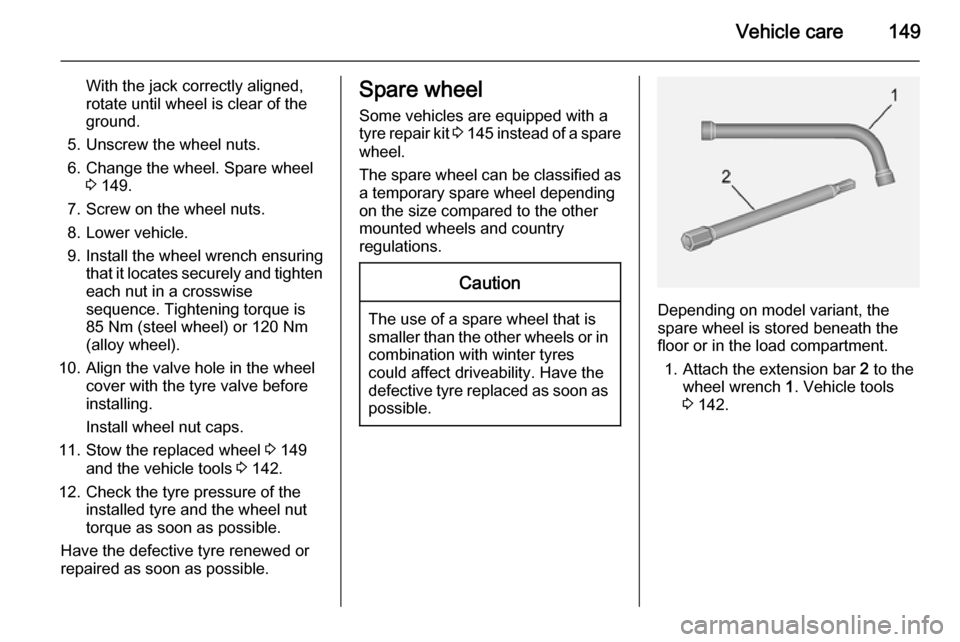ECU VAUXHALL COMBO 2014 User Guide
[x] Cancel search | Manufacturer: VAUXHALL, Model Year: 2014, Model line: COMBO, Model: VAUXHALL COMBO 2014Pages: 187, PDF Size: 4.15 MB
Page 50 of 187

48Seats, restraints
Allow children to enter and exit the
vehicle only on the side facing away
from the traffic.
When the child restraint system is not in use, secure the seat with a seat beltor remove it from the vehicle.
Notice
Do not stick anything on the child
restraint systems and do not cover
them with any other materials.
A child restraint system which has
been subjected to stress in an
accident must be replaced.
Page 51 of 187

Seats, restraints49Child restraint installation locationsPermissible options for fitting a child restraint system
Weight and age class
Front passenger seatSecond rowThird rowactivated airbagdeactivated airbagoutboard seatcentre seatGroup 0: up to 10 kg
or approx. 10 monthsXU 1U,
or approx. 6 to 12 yearsXXUUX1=Only if front airbag system is deactivated. When securing with a three-point seat belt, move seat height adjustment
to uppermost position and ensure that the seat belt runs forwards from the upper anchorage point. Adjust seat
backrest inclination as far as necessary to a vertical position to ensure that the belt is tight on the buckle side.<=Vehicle seat available with ISOFIX attachments. When attaching using ISOFIX, only the ISOFIX child restraint
systems permitted for the vehicle may be used.U=Universal suitability in conjunction with three-point seat belt.X=No child restraint system permitted in this weight class.
Page 57 of 187

Storage55Load compartment
Folding down rear seat
backrests
The rear seat backrest is divided into
two parts. Both parts can be folded
down.
Remove the load compartment cover if necessary.
Press and hold the catch, then push
the head restraints down.
Pull the release lever on one or both
sides and fold down the backrests
onto the seat cushion.
Pull lever to release, the seat base is
tensioned and will start to rise
automatically.
Fold the seat forward completely.
To fold up, lower seats to the floor
until they engage audibly. Raise
backrests and guide them into an
upright position until they engage
audibly.
The backrests are properly engaged
when both red marks on the release
levers are no longer visible.
Ensure that the seat belts are
positioned correctly before returning the seats to the upright position.9 Warning
Only drive the vehicle if the
backrests are securely locked into position. Otherwise there is a risk
of personal injury or damage to the
load or vehicle in the event of
heavy braking or a collision.
Load compartment cover
Extendable load compartment
cover Do not place any heavy or sharp-
edged objects on the extendable load
compartment cover.
Page 59 of 187

Storage57
Rear parcel shelfThe rear parcel shelf consists of two
parts - a front part and rear part. The
front part can be opened or closed,
allowing for greater flexibility in the
load compartment.
Do not place any excessively heavy
or sharp-edged objects on the rear
parcel shelf.9 Warning
Always make sure that the load in
the vehicle is securely stowed.
Otherwise objects can be thrown
around inside the vehicle and
cause personal injury or damage
to the load or car.The rear parcel shelf can be installed
in 2 positions, i.e. the upper position
or the lower position. In the lower
position, the maximum load
permissible is 70 kg.
Removing
If the rear seats are in the folded
position, remove the parcel shelf and
store it horizontally between the back of the front seats and the folded rearseats.Caution
For safety reasons, do not place
loads on the folded rear seats.
Page 60 of 187

58Storage
To remove, lift the front part of the
parcel shelf by releasing it from the
front retainers ( 1) on both sides.
Lift the rear part of the parcel shelf by
releasing it from the rear retainers ( 2
and 3) on both sides.
Installing
Refit the parcel shelf by engaging in
front and rear retainers on both sides.
Lashing eyes
VanThe lashing eyes are designed to
secure items against slippage, e.g.
using lashing straps or a luggage net.
Combo TourRoof rack system
Roof rack For safety reasons and to avoid
damage to the roof, the vehicle
approved roof rack system is
recommended. Contact a workshop
for further information.
Follow the installation instructions
and remove the roof rack when not in
use.
Mounting roof rack
Page 61 of 187

Storage59
To fasten a roof rack, insert the
mounting bolts in the holes indicated
in the illustration.Loading information
■ Heavy objects in the load compartment should be evenly
distributed and placed as far
forward as possible. If objects can
be stacked, the heavier objects
should be placed at the bottom.
■ Secure objects with lashing straps attached to lashing eyes 3 58.
■ Secure loose objects in load compartment to prevent them from
sliding.
■ When transporting objects in the load compartment, the backrests ofthe rear seats must not be tilted
forwards or folded down.
■ Do not allow the load to protrude above the upper edge of the
backrests.
■ Do not place any objects on the extendable load compartment
cover 3 55 or the instrument panel,
and do not cover the sensor on top
of the instrument panel 3 97.■ The load must not obstruct the
operation of the pedals, parking
brake and gear selector, or hinder
the freedom of movement of the
driver. Do not place any unsecured objects in the interior.
■ Do not drive with an open load compartment.9 Warning
Always make sure that the load in
the vehicle is securely stowed.
Otherwise objects can be thrown
around inside the vehicle and
cause personal injury or damage
to the load or car.
■ The payload is the difference between the permitted gross
vehicle weight (see identification
plate 3 161) and the EC kerb
weight.
To calculate the payload, enter the
data for your vehicle in the Weights
table at the front of this manual.
The EC kerb weight includes
weights for the driver (68 kg),
Page 62 of 187

60Storage
luggage (7 kg) and all fluids (tank
90 % full).
Optional equipment and
accessories increase the kerb
weight.
■ Driving with a roof load increases the sensitivity of the vehicle to
cross-winds and has a detrimental
effect on vehicle handling due to
the vehicle's higher centre of
gravity. Distribute the load evenly
and secure it properly with retaining
straps. Adjust the tyre pressure and
vehicle speed according to the load conditions. Check and retighten the
straps frequently.
Do not drive faster than 75 mph.
The permissible roof load (which
includes the weight of the roof rack)
is 100 kg. The roof load is the
combined weight of the roof rack
and the load.
Page 129 of 187

Vehicle care1279Danger
The ignition system use extremely
high voltage. Do not touch.
Bonnet
Opening
Pull the release lever and return it to
its original position.
Push the safety catch and open the
bonnet.
Secure the bonnet support.
If the bonnet is opened during an
Autostop, the engine will be restarted automatically for safety reasons.
Stop-start system 3 103.
Closing Lower the bonnet and allow it to drop
into the catch. Check that the bonnet
is engaged.
Engine oil
Check the engine oil level manually
on a regular basis to prevent damage
to the engine. Ensure that the correct specification of oil is used.
Recommended fluids and lubricants
3 159.
Check with the vehicle on a level
surface. The engine must be at
operating temperature and switched
off for at least 5 minutes.
Pull out the dipstick, wipe it clean, insert it to the stop on the handle, pull
out and read the engine oil level.
Page 150 of 187

148Vehicle care
■ Do not start the vehicle when it israised on the jack.
■ Clean wheel nuts and thread with a
clean cloth before mounting the
wheel.9 Warning
Do not grease wheel bolt, wheel
nut and wheel nut cone.
1. Disengage wheel nut caps with a screwdriver and remove. Pull off
the wheel cover using a suitable
tool.
2. Attach wheel wrench securely and loosen each wheel nut by halfa turn.
3. Vehicle jacking points are located
at the front and rear.
4. Set the jack to the necessary height. Position it directly below
the jacking point in a manner that prevents it from slipping.
Page 151 of 187

Vehicle care149
With the jack correctly aligned,
rotate until wheel is clear of the
ground.
5. Unscrew the wheel nuts. 6. Change the wheel. Spare wheel 3 149.
7. Screw on the wheel nuts.
8. Lower vehicle.
9. Install the wheel wrench ensuring that it locates securely and tighten
each nut in a crosswise
sequence. Tightening torque is
85 Nm (steel wheel) or 120 Nm
(alloy wheel).
10. Align the valve hole in the wheel cover with the tyre valve before
installing.
Install wheel nut caps.
11. Stow the replaced wheel 3 149
and the vehicle tools 3 142.
12. Check the tyre pressure of the installed tyre and the wheel nut
torque as soon as possible.
Have the defective tyre renewed or
repaired as soon as possible.Spare wheel
Some vehicles are equipped with a
tyre repair kit 3 145 instead of a spare
wheel.
The spare wheel can be classified as
a temporary spare wheel depending
on the size compared to the other
mounted wheels and country
regulations.Caution
The use of a spare wheel that is smaller than the other wheels or in combination with winter tyres
could affect driveability. Have the defective tyre replaced as soon as
possible.Depending on model variant, the
spare wheel is stored beneath the
floor or in the load compartment.
1. Attach the extension bar 2 to the
wheel wrench 1. Vehicle tools
3 142.